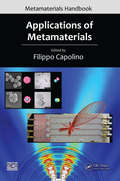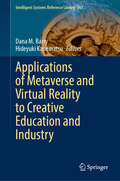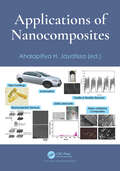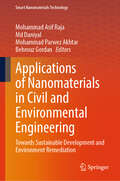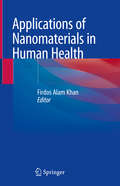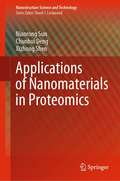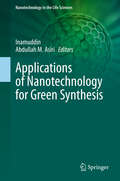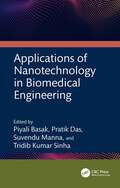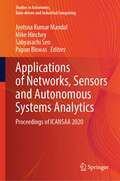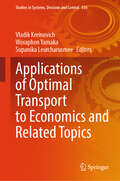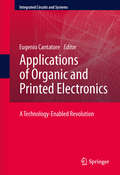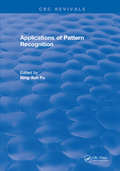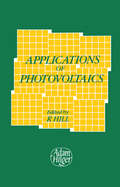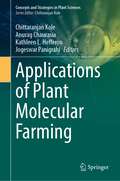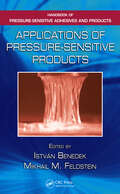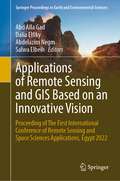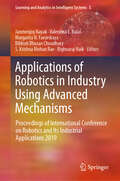- Table View
- List View
Applications of Metamaterials (Metamaterials Handbook)
by Filippo CapolinoThis book uses the first volume’s exploration of theory, basic properties, and modeling topics to develop readers’ understanding of applications and devices that are based on artificial materials. It explores a wide range of applications in fields including electronics, telecommunications, sensing, medical instrumentation, and data storage. The text also includes a practical user’s guide and explores key areas in which artificial materials have developed. It includes experts’ perspectives on current and future applications of metamaterials, to present a well-rounded view on state-of-the-art technologies.
Applications of Metaverse and Virtual Reality to Creative Education and Industry (Intelligent Systems Reference Library #267)
by Hideyuki Kanematsu Dana M. BarryThis book provides excellent examples of metaverse and virtual reality and their unlimited possibilities for education and industry. By examining innovative educational activities in both real and virtual worlds, such as Second Life, SL (a three-dimensional world where avatars perform specific tasks on behalf of us), we get a unique perspective on how these technologies can revolutionize learning and professional practices. Metaverse offers a fully immersive and interconnected virtual environment, enabling individuals to engage in digital experiences that closely resemble real-world interactions, thereby providing limitless possibilities for education and industry. In addition, the chapters cover various key topics, including the integration of virtual reality in creative game design, the use of VR (virtual reality) headsets with sensor glasses for physiological data collection, and the application of VR in fields like architecture and medical education. Artificial Intelligence, Robotics, and Machine Learning (along with other related fields) are also mentioned. In addition, readers will encounter discussions about the future fusion of real and virtual worlds, highlighting the role of Digital Twin Technology and Augmented Reality. The book invites readers to consider critical questions about the implications of these technologies for society and industry. This book is a must-read for students, educators, engineers, and researchers interested in the cutting-edge applications of virtual reality and the metaverse. It serves as a textbook, reference, and practical guide, making it invaluable for academic audiences and professionals seeking to harness the power of these technologies for innovative solutions. Whether you are a professor, scientist, or engineer, or simply curious about the metaverse, avatars, and virtual reality, this book promises to be a rewarding journey into the limitless potential of these technologies for creative education and industry.
Applications of Microfluidic Systems in Biology and Medicine (Bioanalysis #13)
by Manabu TokeshiThis book is the second edition of the one originally published in 2016, which focused on state-of-the-art microfluidic research in medical and biological applications. Similar to the first edition, beginners in the field —undergraduates, engineers, biologists, medical and pharmaceutical researchers—will easily learn to understand microfluidic-based medical and biological applications. Because a wide range of topics is summarized here, it also helps experts to learn more about fields outside their own specialties. In this second edition, significant revisions have been made to chapters covering technologies that have seen major advancements, such as acoustofluidics, protein crystallography, organ-on-a-chip systems, nanopore sensing, and paper-based microfluidics. In addition, the chapters on cancer diagnosis using exosomes and single-cell sequencing using droplet microfluidics, which are attracting attention as new technologies, have been newly added. Readers will be convinced that microfluidic devices have great potential for medical and biological applications.
Applications of Microscopy in Materials and Life Sciences: Proceedings of 12th Asia-Pacific Microscopy Conference (Springer Proceedings in Materials #11)
by C. Barry Carter Partha Ghosal Kutti Ragunath Vinothkumar Rajdeep SarkarThis book comprises the proceedings of the 12th International Conference on Asia-Pacific Microscopy Conference (APMC12) focusing on emerging opportunities and challenges in the field of materials sciences, life sciences and microscopy techniques. The contents of this volume include papers on aberration corrected TEM & STEM, SEM – FIB, ion beam microscopy, electron diffraction & crystallography, microscopy and imaging associated with bio-nanotechnology, medical applications, host-pathogen interaction, etc. This book will be beneficial to researchers, educators, and practitioners alike.
Applications of Nanocomposites
by Ahalapitiya H. JayatissaIn this book, different applications of nanomaterials are described based on experiments, validations, and prototype manufacturing. It also covers synthesis, characterization, functionalization and coating of nanomaterials in various application-oriented investigations. The use of nanomaterials in energy storage, catalyst preparation and tribology are a few examples of improving the efficiency of future technologies. In addition, this book has also contributed to the nanomanufacturing of composites for automobile industries, glass industries, textiles and flexible electronics. This book provides knowledge on multiple related fields in applying nanomaterials, emphasizing the most updated literature, understanding applications, and consists of examples and illustrations so that readers can absorb the content rapidly.
Applications of Nanomaterials for Energy Storage Devices
by Amit Saxena Bhaskar Bhattacharya Felipe Caballero-BrionesElectrochemical energy storage devices are the prime interest of researchers and students. This book provides a comprehensive introduction to nanomaterials and their potential applications specifically for electrochemical devices (rechargeable batteries, supercapacitors and so forth) in a coherent and simple manner. It covers fundamental concepts of nanomaterials, chemical and physical methods of synthesis, properties, characterization methods, and related applications. Features: Introduces the evolution of nanoparticles in electrochemical energy storage devices. Provides the detailed information on step-by-step synthesis of nanoparticles. Discusses different characterization methods (structural, electrical, optical, and thermal). Includes the use of nanoparticles in various electrochemical devices. Aims to bridge the gap between the material synthesis and the real application. This book aims at Senior Undergraduate/Graduate students in Material Chemistry, Electrochemistry and Chemical Engineering, and Energy Storage.
Applications of Nanomaterials in Civil and Environmental Engineering: Towards Sustainable Development and Environment Remediation (Smart Nanomaterials Technology)
by Mohammad Asif Raja Md Daniyal Mohammad Parwez Akhtar Behrouz GordanThis book explores the transformative use of nanomaterials in civil engineering, emphasizing sustainability and innovation in addressing enduring challenges. It covers the enhancement of construction materials, including cementitious composites, coatings, and structural components with nanomaterials to improve corrosion resistance, mechanical properties, and cement performance. The integration of nanotechnology with Industry 4.0 and digital twins is also discussed, promoting smarter engineering practices. Additionally, it details the applications of nanomaterials in pavement construction and soil property enhancement for seismic resilience. It addresses soil stabilization, slope stability, ground improvement, and scour protection for waterfront infrastructure. Furthermore, it delves into environmental engineering applications such as advanced wastewater treatment, soil remediation, and air quality improvement through nanotechnology. This book features seventeen chapters by leading experts, offering research insights and practical guidance for sustainable infrastructure and environmental solutions.
Applications of Nanomaterials in Human Health
by Firdos Alam KhanThis book reviews the various applications of nanotechnology in human health. The introductory chapters focus on the classifications, types, synthesis, and characterization of various types of nanomaterials, while subsequent chapters highlight current applications of nanomaterials in the diagnosis and treatment of microbial and viral infections, and also in stem cell biology and regenerative medicine. Further, the book explores the potential role of nanomaterials in connection with neuronal differentiation, neuronal protection, and neurological diseases. It demonstrates the use of nanotechnology to diagnose and treat genetic disorders, as well as endocrine and metabolic syndrome diseases. It also discusses the ethics and the negative impacts of nanomaterials on human health. Lastly, it examines the intellectual property aspects and government regulations associated with the research, design, and commercialization of nanotechnology-based products. Given its scope, it offers a valuable resource for all researchers and professionals working with nanotechnology-based applications in human health.
Applications of Nanomaterials in Proteomics (Nanostructure Science and Technology)
by Nianrong Sun Chunhui Deng Xizhong ShenThis book provides a comprehensive and systematic overview of the latest advances in nanomaterials for proteomics, both theoretical and practical. Consisting of seven chapters, it first covers the synthesis methods, characterization, principles, and performance of functional nanomaterials in various branches of proteomics in detail. This is followed by the applications of nanomaterials for the separation and analysis of various proteins and peptides. Given its scope, the book appeals to a broad readership, including those active in proteomics and materials science; it can also serve as a reference book for students majoring in proteomics analysis.
Applications of Nanomaterials in Sensors and Diagnostics (Springer Series on Chemical Sensors and Biosensors #14)
by Adisorn TuantranontRecent progress in the synthesis of nanomaterials and our fundamental understanding of their properties has led to significant advances in nanomaterial-based gas, chemical and biological sensors. Leading experts around the world highlight the latest findings on a wide range of nanomaterials including nanoparticles, quantum dots, carbon nanotubes, molecularly imprinted nanostructures or plastibodies, nanometals, DNA-based structures, smart nanomaterials, nanoprobes, magnetic nanomaterials, organic molecules like phthalocyanines and porphyrins, and the most amazing novel nanomaterial, called graphene. Various sensing techniques such as nanoscaled electrochemical detection, functional nanomaterial-amplified optical assays, colorimetry, fluorescence and electrochemiluminescence, as well as biomedical diagnosis applications, e.g. for cancer and bone disease, are thoroughly reviewed and explained in detail. This volume will provide an invaluable source of information for scientists working in the field of nanomaterial-based technology as well as for advanced students in analytical chemistry, biochemistry, electrochemistry, material science, micro- and nanotechnology.
Applications of Nanotechnology for Green Synthesis (Nanotechnology in the Life Sciences)
by Inamuddin Abdullah M. AsiriTraditional methods in synthetic chemistry produce chemical waste and byproducts, yield smaller desired products, and generate toxic chemical substances, but the past two centuries have seen consistent, greener improvements in organic synthesis and transformations. These improvements have contributed to substance handling efficiency by using green-engineered forerunners like sustainable techniques, green processes, eco-friendly catalysis, and have minimized energy consumption, reduced potential waste, improved desired product yields, and avoided toxic organic precursors or solvents in organic synthesis. Green synthesis has the potential to have a major ecological and monetary impact on modern pharmaceutical R&D and organic chemistry fields. This book presents a broad scope of green techniques for medicinal, analytical, environmental, and organic chemistry applications. It presents an accessible overview of new innovations in the field, dissecting the highlights and green chemistry attributes of approaches to green synthesis, and provides cases to exhibit applications to pharmaceutical and organic chemistry. Although daily chemical processes are a major part of the sustainable development of pharmaceuticals and industrial products, the resulting environmental pollution of these processes is of worldwide concern. This edition discusses green chemistry techniques and sustainable processes involved in synthetic organic chemistry, natural products, drug syntheses, as well various useful industrial applications.
Applications of Nanotechnology in Biomedical Engineering
by Suvendu Manna Piyali Basak Pratik Das Tridib Kumar SinhaThis book presents recent advancements in nanotechnology-based innovations in the biomedical sciences and engineering fields, including nanoimaging, nano-delivery of drugs and genes, antimicrobial and antiviral coatings, nano-neutraceuticals, and nano-cosmetics. It covers a wide range of topics, which include nanosensors, nano-based coatings, and wound healing, as well as scope for new research and development. It is a guide to the state-of-the-art nanotechnological advancements in medical image processing and disease detection. Features are as follows: Covers industry-oriented applications of nanomaterials in the field of biomedical engineering Discusses development of nature-inspired nano-engineered nutraceuticals Reviews research on nano-coating to restrict biofilm formation and nosocomial infections Includes different aspects of both medical sciences and health sciences, ranging from medical imaging to cosmetics Explores micro-/nano-SMART devices for biomedical applications This book is aimed at researchers and graduate students in biomedical engineering, nanotechnology, and related areas.
Applications of Nanotechnology in Microbiology
by Ramesh S. Chaughule Anushree S. LokurThis book discusses the applications of nanotechnology in clinical microbiology, food microbiology, and green solutions of nanoparticles using microorganisms for a range of benefits. It describes nanotechnology’s rapid progress in the development of materials used in industry, medicine, drug delivery, and dentistry. The authors further explore how microbiology and nanotechnology separately have proven to be effective for human health solutions keeping an ecological and environmental balance. Domains covered include environmental microbiology, medical microbiology, food microbiology (to control food spoilage), biosynthesis of nanomaterials using microorganisms, water microbiology, nanofluidic devices for isolation and analysis of individual biomolecules such as DNA that can lead to a new detection scheme for cancer, and various fields such as pharmacy, clinical research, agriculture etc. This book will be essential reading to a wide range of scholars and researchers interested in microbiology along with nanotechnology applications for efficient solutions to cancer detection, biosensors, vaccines research, agriculture, wastewater management etc.
Applications of Networks, Sensors and Autonomous Systems Analytics: Proceedings of ICANSAA 2020 (Studies in Autonomic, Data-driven and Industrial Computing)
by Mike Hinchey Papun Biswas Jyotsna Kumar Mandal Sabyasachi SenThis book presents high-quality research papers presented at International Conference on Applications of Networks, Sensors and Autonomous Systems Analytics (ICANSAA 2020), held during December, 11 – 12, 2020, at JIS College of Engineering, Kalyani, West Bengal, India. The major topics covered are cyber-physical systems and sensor networks, data analytics and autonomous systems and MEMS and NEMS with applications in biomedical devices. It includes novel and innovative work from experts, practitioners, scientists, and decision-makers from academia and industry.
Applications of Optimal Transport to Economics and Related Topics (Studies in Systems, Decision and Control #556)
by Vladik Kreinovich Woraphon Yamaka Supanika LeurcharusmeeOften, when a new successful data processing techniques appears in one of the application areas, it then proves to be useful in many other areas. This was the case of optimal transportation techniques: these techniques were first developed for transportation problems, but now they have been shown to be successful in many statistical applications, including applications to economics. These techniques are the main focus of this book, but this book also contain papers that use other techniques, ranging from more traditional statistical approaches to more recent ones such as stochastic frontier methods, multivariable quantiles, random forest, and deep learning. Applications include all aspects of economics, from production (including agricultural) to trade (including international) and finances, with relation to issues of crime (including computer crime and cyberbullying), demographics, economic freedom, environment, health, and tourism. We hope that this volume will: help practitioners to become better knowledgeable of the state-of-the-art econometric techniques, especially optimal transport techniques, and help researchers to further develop these important research directions. We want to thank all the authors for their contributions and all anonymous referees for their thorough analysis and helpful comments. The publication of this volume was partly supported by the Faculty of Economics of the Chiang Mai University, Thailand. Our thanks to the leadership and staff of the Chiang Mai University for providing crucial support. Our special thanks to Prof. Hung T. Nguyen for his valuable advice and constant support.
Applications of Organic and Printed Electronics: A Technology-Enabled Revolution (Integrated Circuits and Systems)
by Eugenio CantatoreOrganic and printed electronics can enable a revolution in the applications of electronics and this book offers readers an overview of the state-of-the-art in this rapidly evolving domain. The potentially low cost, compatibility with flexible substrates and the wealth of devices that characterize organic and printed electronics will make possible applications that go far beyond the well-known displays made with large-area silicon electronics. Since organic electronics are still in their early stage, undergoing transition from lab-scale and prototype activities to production, this book serves as a valuable snapshot of the current landscape of the different devices enabled by this technology, reviewing all applications that are developing and those can be foreseen.
Applications of Palaeontology
by Robert Wynn JonesPalaeontology, the scientific study of fossils, has developed from a descriptive science to an analytical science used to interpret relationships between earth and life history. This book provides a comprehensive and thematic treatment of applied palaeontology, covering the use of fossils in the ordering of rocks in time and in space, in biostratigraphy, palaeobiology and sequence stratigraphy. Robert Wynn Jones presents a practical workflow for applied palaeontology, including sample acquisition, preparation and analysis, and interpretation and integration. He then presents numerous case studies that demonstrate the applicability and value of the subject to areas such as petroleum, mineral and coal exploration and exploitation, engineering geology and environmental science. Specialist applications outside of the geosciences (including archaeology, forensic science, medical palynology, entomopalynology and melissopalynology) are also addressed. Abundantly illustrated and referenced, Applications of Palaeontology provides a user-friendly reference for academic researchers and professionals across a range of disciplines and industry settings.
Applications of Pattern Recognition: [proceedings Of The Nato Advanced Study Institute On Pattern Recognition-theory And Application, Bandol, France, September 1975] (Nato Science Series E: Ser. #22)
by King-Sun FuThis monograph is intended to cover several major applications of pattern recognition. After a brief introduction to pattern recognition in Chapter 1, the two major approaches, statistical approach and syntactic approach, are reviewed in Chapter 2, and 3, respectively. Other topics include the application of pattern recognition to seismic wave interpretation, to system reliability problems, to medical data analysis, as well as character and speech recognition.
Applications of Photovoltaics
by R HillPhotovoltaics (PV) play a vital role in an energy-conscious society where the demand for cheap, convenient, and environmentally benign sources of energy is certain to increase. The range of applications is immense, encompassing many spheres of activity, from modern consumer electronics to the supply of power. Bringing together experts in their fields, Applications of Photovoltaics provides a stimulating account of the technical and economic aspects of the many areas that PV technology has been or is soon to be implemented. The book includes chapters on terrestrial applications of PV; PV for development, placing PV in the context of an energy policy for developing countries; PV for developing countries, which discusses the techno-economics of PV applications; PV systems for professional applications, which include hybrid systems; and low-power applications of PV for consumer, leisure, and other systems. Applications of Photovoltaics is appealing to all engineers, from energy advisors and policy makers, with an interest in or need for off-grid electrical supplies, from microwatts to megawatts. Its level of presentation makes it accessible to those without an engineering or economics background.
Applications of Plant Molecular Farming (Concepts and Strategies in Plant Sciences)
by Chittaranjan Kole Anurag Chaurasia Kathleen L. Hefferon Jogeswar PanigrahiThis edited book is a comprehensive compilation of applications of plant molecular farming in various fields including agriculture, industry and medicine, using different plant/crop systems as bioreactors for the bulk production of products of interest. The book places special emphasis on plant molecular farming being utilized for the bulk production of biologics, industrial enzymes, vaccines, drugs and recombinant pharmaceutical proteins.Plant molecular farming (PMF) is an upcoming promising interdisciplinary subject, and therefore the book contains contributions from experts across the disciplines. The utilization of plant viral vectors to produce biologics, virus-like particles and antimicrobial peptides via PMF have been highlighted. Molecular farming for the bulk production of recombinant pharmaceutical proteins and various types of human and veterinary vaccines in different crops/plants and genetically modified seeds has been included. The process of scaling up to manufacturing capacity, product formation by bioprocessing of plant cell suspension culture, and bioreactor engineering have been incorporated. Lastly, the book provides special coverage on utilizing PMF made products to control neglected tropical diseases and plant-made antigens as immunotherapies for allergic and autoimmune diseases.The book has chapters from leading experts on the subject, making it equally beneficial for researchers, policy planners, industrialists, medical professionals, entrepreneurs, and students of various related disciplines.
Applications of Polymer Nanofibers
by Anthony L. Andrady Saad A. KhanAPPLICATIONS OF POLYMER NANOFIBERS Explore a comprehensive review of the practical experimental and technological details of polymer nanofibers with a leading new resource Applications of Polymer Nanofibers delivers a complete introduction to the basic science of polymer nanofibers as well as a review of their diverse applications. The book assesses their potential for commercialization and presents contributions from leading experts emphasizing their practical and technological details. New and up to date research findings are presented throughout the book in areas including filters, fabric, energy, fuel cells, batteries, sensors, biomedicine, drug delivery, tissue engineering, and wound dressings. The book also presents a fulsome analysis of the technology of electrospinning, the most convenient and scalable technique for nanofiber production. It also provides readers with practical information on relevant surface modification techniques. Applications of Polymer Nanofibers effectively balances theoretical background with practical applications of the technology, including insights into polymer nanofiber materials that will be useful for advanced students and researchers. Students, researchers, and industry professionals will also enjoy the inclusion of: A thorough introduction to electrospinning parameters and resulting nanofiber characteristics, including theoretical and practical considerations An exploration of textile applications of nanofibers, like protective clothing, filter fabrics, wearable devices, functional fabrics, and biomedical textiles A review of nanofiber mats as high-efficiency filters, including filtration developments, filters made with nanofibers, and the future outlook for nanofiber filters A treatment of nanofiber-based chemical sensors, including sensor materials, approaches to nanofiber sensor design, and gravimetric nanofiber sensors Perfect for researchers and graduate students studying polymer science and engineering, chemical engineering, materials science, and nanotechnology. Applications of Polymer Nanofibers will also earn a place in the libraries of industrial researchers concerned with electrospinning, air filtration, fabrics, drug delivery, catalysis, and biomedicine.
Applications of Pressure-Sensitive Products (Handbook of Pressure-Sensitive Adhesives and Products)
by Mikhail M. Feldstein IstvÁn BenedekPresenting the end-use and application technologies of pressure-sensitive adhesives and products, Volume Three of the Handbook of Pressure-Sensitive Adhesives and Products discusses the build up and classes
Applications of Quality Control in the Service Industries (Quality and Reliability)
by A. C. RosanderThis book discusses basic concepts, principles, and quality characteristics in the service industries, an understanding of the techniques and their applications. It helps to close the gap between proven principles and successful applications.
Applications of Remote Sensing and GIS Based on an Innovative Vision: Proceeding of The First International Conference of Remote Sensing and Space Sciences Applications, Egypt 2022 (Springer Proceedings in Earth and Environmental Sciences)
by Abdelazim Negm Abd Alla Gad Dalia Elfiky Salwa ElbeihThis book covers various aspects of remote sensing and geographic information systems, from the perspective of earth and environmental sciences. The theme of applications of remote sensing and geographic information systems for the purposes of sustainable development highlights the innovative usage of space imaged spectral data in soil characterization. This book merges the selected contributions to the First International Conference of Remote Sensing and Space Sciences Applications (Egypt 2022) aiming to promote the latest findings on the development of Space Technologies and Applications.
Applications of Robotics in Industry Using Advanced Mechanisms: Proceedings of International Conference on Robotics and Its Industrial Applications 2019 (Learning and Analytics in Intelligent Systems #5)
by Margarita N. Favorskaya Janmenjoy Nayak Bighnaraj Naik Valentina E. Balas Bibhuti Bhusan Choudhury S. Krishna Mohan RaoThis book shares important findings on the application of robotics in industry using advanced mechanisms, including software and hardware. It presents a collection of recent trends and research on various advanced computing paradigms such as soft computing, robotics, smart automation, power control, and uncertainty analysis. The book constitutes the proceedings of the 1st International Conference on Application of Robotics in Industry using Advanced Mechanisms (ARIAM2019), which offered a platform for sharing original research findings, presenting innovative ideas and applications, and comparing notes on various aspects of robotics. The contributions highlight the latest research and industrial applications of robotics, and discuss approaches to improving the smooth functioning of industries. Moreover, they focus on designing solutions for complex engineering problems and designing system components or processes to meet specific needs, with due considerations for public health and safety, including cultural, societal, and environmental considerations. Taken together, they offer a valuable resource for researchers, scientists, engineers, professionals and students alike.
